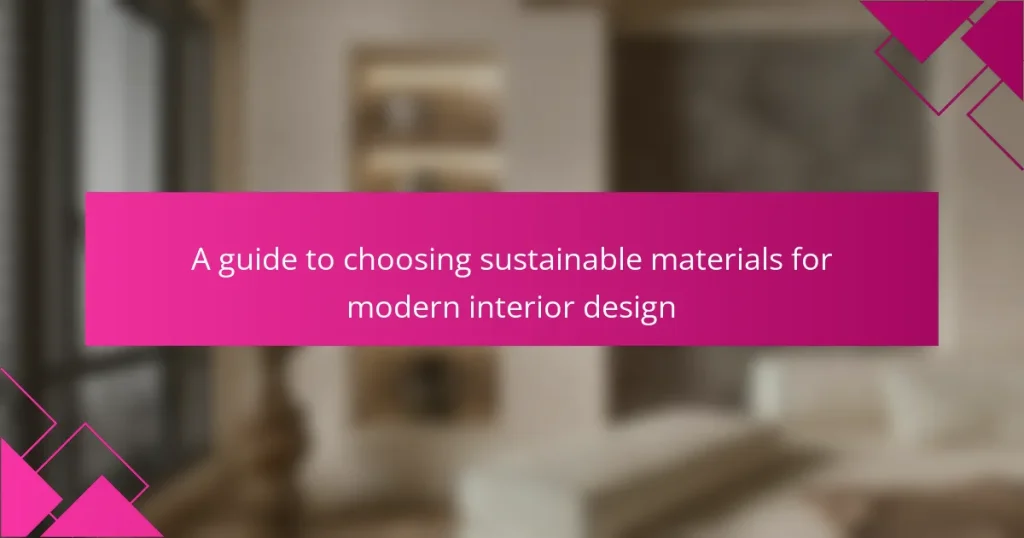Sustainable materials are resources used in modern interior design that minimize environmental impact through renewability, recycling, or low toxicity. Key examples include bamboo, reclaimed wood, recycled metal, and low-VOC paints, each contributing to eco-friendly design practices. This guide emphasizes the importance of evaluating environmental impact, availability, and lifecycle when selecting sustainable materials. It also highlights the benefits of local sourcing, energy-efficient production, and certifications like FSC to ensure responsible sourcing. Prioritizing these factors supports sustainability efforts while enhancing indoor air quality and reducing waste.

What are sustainable materials in modern interior design?
Sustainable materials in modern interior design are resources that minimize environmental impact. These materials are typically renewable, recycled, or have low toxicity. Examples include bamboo, reclaimed wood, recycled metal, and low-VOC paints. Bamboo grows rapidly and absorbs carbon dioxide efficiently. Reclaimed wood reduces deforestation and utilizes existing resources. Recycled metal lowers energy consumption during production. Low-VOC paints improve indoor air quality. Utilizing these materials contributes to eco-friendly design practices and supports sustainability efforts.
Why is sustainability important in interior design?
Sustainability is important in interior design because it minimizes environmental impact. Sustainable design practices reduce waste and promote resource efficiency. This approach often incorporates renewable materials and energy-efficient systems. For example, using reclaimed wood can lower deforestation rates. Additionally, sustainable interiors improve indoor air quality by using non-toxic materials. Research indicates that sustainable buildings can reduce energy costs by up to 30%. These practices contribute to a healthier planet and enhance occupants’ well-being.
What environmental impacts do traditional materials have?
Traditional materials often lead to significant environmental impacts. Their extraction and processing can result in habitat destruction and biodiversity loss. For example, logging for timber can devastate forests, disrupting ecosystems. Additionally, traditional materials like clay and stone require energy-intensive processing, contributing to greenhouse gas emissions. The transportation of these materials also adds to their carbon footprint. Furthermore, some traditional materials may contain harmful chemicals that pollute air and water during production. These factors highlight the need for careful consideration of traditional materials in sustainable design practices.
How does using sustainable materials benefit the planet?
Using sustainable materials benefits the planet by reducing environmental impact. These materials often require less energy to produce. This leads to lower greenhouse gas emissions. Sustainable materials also minimize waste through recyclable or biodegradable properties. For instance, bamboo grows rapidly and absorbs carbon dioxide efficiently. Additionally, using local sustainable materials reduces transportation emissions. This supports local economies and decreases reliance on fossil fuels. The choice of sustainable materials promotes biodiversity by protecting ecosystems. Therefore, their use contributes to a healthier planet.
What types of sustainable materials are available?
Sustainable materials include bamboo, recycled metal, reclaimed wood, cork, and organic cotton. Bamboo is a fast-growing grass that requires minimal resources. Recycled metal reduces waste and energy consumption in production. Reclaimed wood repurposes old timber, minimizing deforestation. Cork is harvested from the bark of cork oak trees without harming them. Organic cotton is grown without synthetic pesticides or fertilizers, promoting healthier ecosystems. These materials contribute to eco-friendly practices in modern interior design.
What are the characteristics of natural materials?
Natural materials are derived from organic sources and possess unique characteristics. They are biodegradable, ensuring minimal environmental impact. Natural materials exhibit durability, often lasting longer than synthetic alternatives. They offer aesthetic appeal through unique textures and colors. These materials typically have low toxicity, promoting healthier indoor air quality. Natural materials also provide thermal insulation, contributing to energy efficiency. Their production often involves less energy compared to synthetic materials. Examples include wood, stone, and cotton, each showcasing these defining traits.
How do recycled materials contribute to sustainability?
Recycled materials contribute to sustainability by reducing waste and conserving natural resources. When materials are recycled, they prevent the accumulation of waste in landfills. This process also decreases the need for new raw materials, which often require energy-intensive extraction and processing. For instance, recycling aluminum saves up to 95% of the energy needed to produce new aluminum from ore. Additionally, using recycled materials lowers greenhouse gas emissions associated with manufacturing. According to the Environmental Protection Agency, recycling and composting prevented the release of 186 million metric tons of carbon dioxide equivalent into the air in 2018. Thus, recycled materials play a crucial role in promoting environmental sustainability.
How can sustainable materials enhance interior aesthetics?
Sustainable materials can enhance interior aesthetics by providing natural beauty and unique textures. These materials often feature organic patterns and colors that create a warm and inviting atmosphere. For instance, reclaimed wood can add character and history to a space. Bamboo is known for its sleek look and durability, making it visually appealing. Additionally, sustainable materials are often eco-friendly, aligning with modern design trends that prioritize environmental consciousness. The use of such materials can increase property value, as buyers increasingly favor sustainable features. Studies show that homes with sustainable elements can sell for 10% more than those without, reflecting their aesthetic and practical appeal.
What design styles complement sustainable materials?
Minimalism, Scandinavian design, and industrial style complement sustainable materials. Minimalism emphasizes simplicity and functionality, often using eco-friendly materials. Scandinavian design focuses on natural elements and light, promoting sustainability through wood and textiles. Industrial style incorporates reclaimed materials, enhancing both aesthetics and environmental responsibility. These styles prioritize durability and resource efficiency, aligning with sustainable principles.
How do colors and textures of sustainable materials influence a space?
Colors and textures of sustainable materials significantly influence a space’s aesthetic and emotional impact. Warm colors like earthy tones create a welcoming atmosphere. Cool colors, such as greens and blues, promote calmness and serenity. Textures add depth and interest, enhancing the sensory experience of a room. For instance, a rough texture can evoke a rustic feel, while smooth surfaces may convey modernity. Research shows that color psychology affects mood and behavior. A study by the Institute for Color Research indicates that people make subconscious judgments about environments within 90 seconds, influenced by color alone. Thus, selecting sustainable materials with intentional colors and textures can transform a space significantly.

What factors should you consider when choosing sustainable materials?
When choosing sustainable materials, consider their environmental impact, availability, and lifecycle. Environmental impact refers to how the material affects ecosystems during production and disposal. Availability ensures that the material can be sourced sustainably and consistently. Lifecycle includes assessing the material’s durability and recyclability.
For instance, bamboo is a sustainable option due to its rapid growth and renewability. Recycled materials, like reclaimed wood, reduce waste and resource consumption. Certifications, such as FSC (Forest Stewardship Council), indicate responsible sourcing.
Additionally, energy consumption during production plays a crucial role in sustainability. Low-energy manufacturing processes minimize carbon footprints. Finally, local sourcing reduces transportation emissions, further enhancing sustainability.
How do cost and budget impact material selection?
Cost and budget significantly influence material selection in interior design. Designers must evaluate the financial constraints of a project. Higher-quality materials often come with increased costs. Limited budgets may necessitate the use of more affordable alternatives. Cost-effective materials can still meet design aesthetics if chosen wisely. Additionally, budget constraints can affect the sustainability of materials. Sustainable options may have higher upfront costs but can save money in the long run through durability. According to a study by the National Institute of Building Sciences, long-term savings from energy-efficient materials can offset initial expenses. Thus, balancing cost and quality is essential for effective material selection.
What are the long-term savings associated with sustainable materials?
Sustainable materials can lead to significant long-term savings. These materials often have a longer lifespan compared to conventional options. For example, bamboo and reclaimed wood are durable and reduce the need for frequent replacements. Additionally, sustainable materials can lower energy costs. They often have better insulation properties, which can decrease heating and cooling expenses.
Using recycled materials can also reduce waste disposal costs. Many sustainable options require less maintenance, saving on upkeep over time. Furthermore, investing in sustainable materials can increase property value. Homes built with eco-friendly materials often attract higher resale prices. According to a 2020 report by the National Association of Realtors, homes with sustainable features sell for 6-8% more than traditional homes. Thus, the long-term savings associated with sustainable materials are both financial and environmental.
How can you balance quality and affordability in your choices?
To balance quality and affordability in your choices, prioritize materials that offer durability without excessive cost. Research sustainable materials that have a proven track record of longevity, such as bamboo or recycled wood. These materials often provide a good balance between performance and price. Compare prices from multiple suppliers to find competitive options. Look for certifications that indicate quality standards, such as FSC for wood products. This ensures the materials are sustainably sourced and reliable. Additionally, consider investing in fewer high-quality items rather than many lower-quality ones. This approach often leads to long-term savings and satisfaction.
What certifications should you look for in sustainable materials?
Look for certifications like FSC, GOTS, and Cradle to Cradle in sustainable materials. FSC (Forest Stewardship Council) ensures responsible sourcing of wood products. GOTS (Global Organic Textile Standard) certifies organic textiles, ensuring environmentally and socially responsible production. Cradle to Cradle certification evaluates products for safety and sustainability throughout their lifecycle. These certifications provide assurance that materials meet rigorous environmental and social criteria.
What do certifications like FSC and LEED signify?
Certifications like FSC and LEED signify adherence to sustainability standards in materials and building practices. FSC, or Forest Stewardship Council, ensures that wood products come from responsibly managed forests. This certification promotes environmentally appropriate, socially beneficial, and economically viable management of forests. LEED, or Leadership in Energy and Environmental Design, signifies that a building meets high standards for energy efficiency and environmental responsibility. LEED certification assesses various aspects, including water usage, energy efficiency, and materials used. Both certifications help consumers identify products and buildings that contribute positively to environmental sustainability. They also encourage manufacturers and builders to adopt sustainable practices.
How can you verify the sustainability claims of materials?
To verify the sustainability claims of materials, check for third-party certifications. Certifications like FSC, Cradle to Cradle, or LEED indicate adherence to sustainability standards. Review the material’s lifecycle assessment (LCA) for environmental impact data. Examine the supply chain transparency to ensure ethical sourcing. Consult manufacturer disclosures for detailed information on sourcing and production practices. Research the brand’s sustainability policies and practices for consistency. Cross-reference claims with independent studies or reports on the material. These steps provide a comprehensive approach to validating sustainability claims.
How do you assess the durability of sustainable materials?
To assess the durability of sustainable materials, you evaluate their performance over time under various conditions. Key factors include resistance to wear, moisture, and environmental impacts. Testing methods such as accelerated aging and stress tests provide data on longevity. Additionally, certifications like LEED and Cradle to Cradle indicate material quality. Research shows that materials like bamboo and recycled metals exhibit high durability ratings. For instance, bamboo can last over 20 years in flooring applications. Thus, both empirical testing and certification standards are essential for accurate durability assessment.
What factors influence the lifespan of sustainable materials?
The lifespan of sustainable materials is influenced by several key factors. Material composition plays a crucial role; natural fibers often have different durability compared to synthetic alternatives. Environmental conditions also impact lifespan; exposure to moisture, sunlight, and temperature fluctuations can cause degradation. Maintenance practices are essential; regular care can extend the life of sustainable materials. Manufacturing processes affect durability; high-quality production methods typically yield longer-lasting products. Usage patterns are significant; materials subjected to heavy wear will have a shorter lifespan. Lastly, recycling potential can influence longevity; materials designed for reuse may have extended life cycles.
How can maintenance requirements affect material choice?
Maintenance requirements significantly influence material choice in interior design. Materials that require less frequent maintenance are often preferred for their practicality. For example, high-durability materials like porcelain tiles resist wear and are easier to clean. In contrast, materials like natural wood may need regular sealing and refinishing, increasing long-term upkeep. The choice of materials can also affect cost; lower maintenance materials can reduce labor and replacement expenses over time. Additionally, environmental factors like humidity can dictate material durability and maintenance needs. Choosing materials that align with maintenance capabilities ensures sustainability and longevity in design.

What are the best practices for implementing sustainable materials in your design?
Use locally sourced materials to reduce transportation emissions. Choose materials with low environmental impact. Opt for recycled or upcycled materials whenever possible. Select renewable materials that can be replenished naturally. Prioritize non-toxic finishes to ensure indoor air quality. Incorporate materials with a long lifespan to minimize waste. Ensure that materials are certified by recognized sustainability standards. Engage in a life cycle assessment to evaluate environmental impact.
How can you integrate sustainable materials into existing spaces?
Integrating sustainable materials into existing spaces involves careful selection and application. Start by assessing the current materials in use. Identify areas where sustainable alternatives can be introduced. For instance, replace conventional flooring with bamboo or reclaimed wood. Use recycled glass for countertops and tiles. Incorporate low-VOC paints to improve indoor air quality. Ensure that insulation materials are eco-friendly, such as cellulose or sheep’s wool.
Research shows that using sustainable materials can reduce environmental impact significantly. According to a study by the U.S. Green Building Council, buildings using sustainable materials can reduce energy consumption by up to 30%. This approach not only benefits the environment but also enhances the aesthetic appeal of the space.
What renovation strategies maximize sustainability?
Renovation strategies that maximize sustainability include using energy-efficient materials and practices. Incorporating recycled materials reduces waste and conserves resources. Implementing energy-efficient appliances lowers energy consumption significantly. Utilizing natural light through design enhances energy savings. Installing water-efficient fixtures conserves water resources effectively. Employing sustainable insulation materials improves energy efficiency. Choosing low-VOC paints and finishes enhances indoor air quality. These strategies contribute to a reduced environmental impact during renovations.
How can you create a cohesive design with sustainable materials?
To create a cohesive design with sustainable materials, select a unified color palette. This palette should harmonize with the materials’ natural tones. Choose materials with similar textures to enhance visual coherence. Incorporate sustainable materials that complement each other, such as reclaimed wood and organic fabrics. Ensure that the design style aligns, whether it’s modern, rustic, or minimalist. Use sustainable finishes that match the overall aesthetic. Consistency in design elements, like furniture and accessories, reinforces cohesion. Research shows that cohesive design improves user experience and satisfaction in interior spaces.
What tips can help you choose the right sustainable materials?
To choose the right sustainable materials, prioritize those with low environmental impact. Look for materials sourced from renewable resources, such as bamboo or reclaimed wood. Ensure the materials are certified by recognized organizations, like the Forest Stewardship Council (FSC). Consider the lifecycle of the materials, including durability and recyclability. Evaluate the production processes for energy efficiency and minimal waste. Research local suppliers to reduce transportation emissions. Choose non-toxic finishes and adhesives to enhance indoor air quality. Finally, stay informed about emerging sustainable materials and innovations in the industry.
How do you research and source sustainable options?
To research and source sustainable options, identify credible sources that specialize in sustainability. Look for databases, journals, and organizations focused on eco-friendly materials. Use search engines to find articles and reports detailing sustainable practices. Evaluate the lifecycle of materials to understand their environmental impact. Check certifications like FSC or Cradle to Cradle for assurance of sustainability. Attend workshops or webinars hosted by experts in sustainable design. Engage with communities and forums that discuss sustainable materials. Utilize social media platforms to follow influencers in the sustainability sector for insights and trends.
What common pitfalls should you avoid when selecting materials?
Common pitfalls to avoid when selecting materials include overlooking sustainability certifications. Many materials may appear eco-friendly but lack verified certifications. Failing to consider the lifecycle of materials is another mistake. Materials with short lifespans may lead to increased waste. Ignoring the environmental impact of extraction processes can also be detrimental. Some materials might be sustainable in use but harmful to the environment during production. Additionally, neglecting local sourcing can increase carbon footprints. Local materials often have lower transportation emissions. Lastly, not accounting for maintenance requirements can lead to higher long-term costs. Certain materials may require more upkeep, impacting sustainability.
The main entity of the article is sustainable materials in modern interior design. The article provides a comprehensive guide on selecting sustainable materials, emphasizing their environmental benefits and aesthetic appeal. Key topics include the importance of sustainability, types of sustainable materials, their characteristics, and how to assess their durability and certifications. The article also outlines best practices for integrating sustainable materials into design, renovation strategies to maximize sustainability, and tips for avoiding common pitfalls in material selection. Overall, it serves as a resource for making informed decisions that contribute to eco-friendly interior design.


